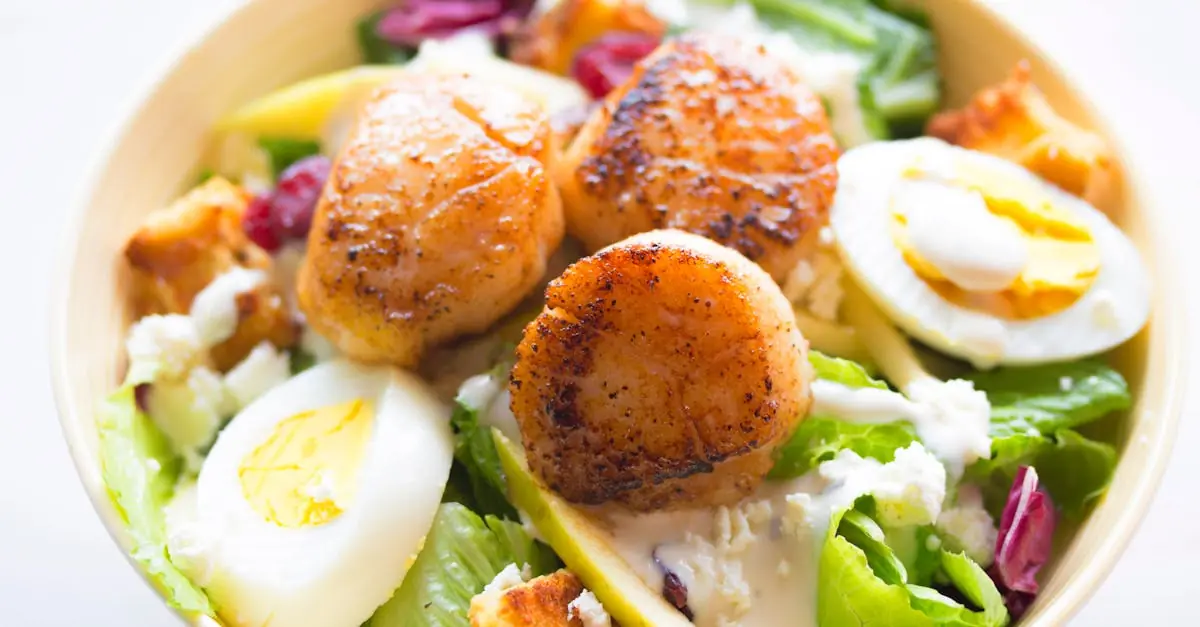Croutons are the unsung heroes of the culinary world. They’re the crunchy little nuggets that turn a simple salad into a gourmet experience. Who knew that leftover bread could be transformed into such delightful morsels? Whether they’re sprinkled on soups or tossed in salads, croutons add that perfect crunch that makes every bite a joy.
Table of Contents
ToggleWhat Are Croutons?
Croutons are small pieces of toasted or fried bread used to add texture and flavor to various dishes. They often enhance salads, soups, and casseroles. Typically, croutons come from stale or leftover bread, making them a practical use of ingredients that might otherwise go to waste.
Various types of bread can be transformed into croutons, including baguettes, sourdough, or whole wheat. Each bread type offers a unique flavor profile and texture. A light seasoning, such as garlic, herbs, or cheese, can elevate the taste, making croutons a versatile addition to meals.
In culinary terms, croutons serve multiple purposes. They provide crunchiness to salads and act as a thickening agent in soups, especially when soaked. These little morsels also contribute to the visual appeal of a dish, adding color and contrast.
Making croutons is straightforward. Bread is cut into cubes and then baked or sautéed until golden brown. Attention to timing during the cooking process ensures a crispy texture without burning. Storing homemade croutons in an airtight container maintains their freshness and crispness.
Croutons offer more than just a topping; they can be a standalone snack. With endless seasoning possibilities, they cater to a variety of taste preferences. Chefs and home cooks alike value croutons for their ability to enhance meals effortlessly.
Types Of Croutons
Croutons come in various forms, each offering unique benefits and flavor profiles. Understanding the differences helps cooks choose the right type for their dishes.
Store-Bought Croutons
Store-bought croutons provide convenience for busy cooks. Packed in bags, they come in different flavors like garlic, cheese, or herb. Consumers find them ready to use, requiring no preparation time. Popular brands ensure consistent texture and crunch. They serve well in salads, soups, or as toppings, easily enhancing dishes without extra effort. Shoppers appreciate the shelf-stability, making bulk purchases practical.
Homemade Croutons
Homemade croutons allow for customization and creativity in cooking. Cooks use leftover bread pieces from various types, like sourdough, whole wheat, or baguetes. Seasoning options include garlic powder, Italian herbs, or even paprika, personalizing flavors to specific preferences. The baking process involves cutting bread, tossing it in oil and seasonings, and baking until golden brown. Doing this creates a crunchy texture with an aromatic scent. Homemade croutons add freshness and enhance the overall meal enjoyment.
Ingredients Needed
Croutons require simple ingredients. A focus on bread and seasonings transforms ordinary meals into delightful culinary experiences.
Bread Selection
Choosing the right bread is essential for croutons. Stale or leftover bread works best due to its density. Baguettes, sourdough, and whole wheat provide unique flavors. Italian or French bread also offers excellent texture. Each type contributes distinct taste profiles that enhance the final product. A variety of sizes, from small cubes to larger chunks, can create different textures when toasted. Fresh bread can be used, but a day or two old ensures optimal crunchiness.
Seasoning Options
Seasoning croutons opens a world of flavor possibilities. Olive oil is a traditional choice that enhances taste while adding moisture. Garlic powder, onion powder, and Italian herbs deliver a savory kick. Dried basil or oregano can infuse Mediterranean flavors into the mix. For those who appreciate heat, red pepper flakes or chili powder adds a bold element. Cheese, such as grated Parmesan or nutritional yeast, can bring richness and depth. Experimenting with spices encourages personalized creations that match specific dishes or preferences.
Steps To Make Croutons
Making croutons involves simple steps that transform leftover bread into flavorful bites. Follow the instructions for a delicious addition to salads and soups.
Preparation Process
Select stale or leftover bread for the best results. Cut the bread into cubes, aiming for a uniform size to ensure even cooking. Use a large bowl to combine the bread with oil and seasonings. Olive oil works well as a base, while various spices, such as garlic powder or Italian herbs, enhance flavor. Toss the bread cubes until all pieces are coated evenly with the oil mixture.
Baking Instructions
Preheat the oven to 375°F (190°C) to create the perfect baking environment. Spread the seasoned bread cubes in a single layer on a baking sheet, allowing space between them for optimal airflow. Bake for 15 to 20 minutes, turning the croutons halfway through to achieve an even golden color. Keep a close eye during the final minutes to prevent burning, as they can brown quickly. Once finished, cool the croutons completely before serving or storing.
Tips For Perfect Croutons
Select the right bread for the best texture. Stale baguettes, sourdough, and whole wheat varieties make excellent choices. Cut the bread into uniform cubes to ensure even cooking. Aiming for approximately half-inch size allows for optimal crunchiness.
Coat bread cubes evenly with oil and seasonings. Olive oil enhances flavor and crispness. Adding garlic powder or Italian herbs enhances the overall taste profile. Tossing the bread in a large bowl ensures uniform coverage, making each piece flavorful.
Monitor baking time closely to avoid burning. Croutons typically bake for 15 to 20 minutes at 375°F (190°C). Turning them halfway through promotes even browning. Checking for a golden color signals that they’re nearly ready.
Allow croutons to cool completely after baking. Cooling prevents sogginess and helps maintain crunch. Storing them in an airtight container preserves freshness. Keeping them at room temperature works well for short-term storage.
Experiment with different seasonings to create a unique flavor profile. Incorporating spices like paprika or cumin can add an unexpected twist. Combining various bread types and flavors provides diversity to dishes, making meals more exciting.
Make adjustments based on personal preferences. For those who enjoy a spicy kick, include chili powder or crushed red pepper. Trying different oils, such as garlic-infused oil, can elevate the flavor even further.
Croutons are more than just a topping; they’re a flavorful enhancement that can transform any dish. Whether opting for store-bought convenience or crafting homemade versions, the versatility of croutons can’t be overstated. With the ability to customize flavors and textures, they provide an exciting way to elevate salads and soups.
By following simple preparation steps and experimenting with various seasonings, anyone can enjoy the delightful crunch that croutons bring to the table. As a practical use of leftover bread, they not only reduce waste but also add a gourmet touch to everyday meals. Embrace the art of crouton-making and let your culinary creativity shine.




